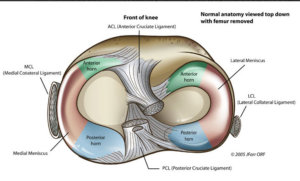What is a Meniscus?
 A meniscus is a piece of soft tissue that lines the knee joint. The purpose of this soft tissue is to absorb shock, provide joint lubrication, and improve joint stability.
A meniscus is a piece of soft tissue that lines the knee joint. The purpose of this soft tissue is to absorb shock, provide joint lubrication, and improve joint stability.
There is a medial and a lateral portion of the meniscus. The medial meniscus is more susceptible to injury than the lateral due to it’s inflexibility. The medial and lateral meniscus are each divided into three sections; the anterior horn, center, and posterior horn. 70% of injuries occur in the posterior horn.
Meniscal Injury Symptoms
- Tenderness to the joint line
- Clicking or popping of the knee
- Painful gait
- Swelling to the joint line
- Pain with deep flexion, extension, or rotation of the knee
Mechanism of Meniscus Injury
Meniscus injuries typically occur when the knee is bent into 20-30 degrees of knee flexion. Acute meniscus injuries happen when one is weightbearing and there is excessive rotation to the knee joint. The rotation can come from poor mechanics or from an external force (getting tackled).
Chronic meniscal injuries occur when there was a knee injury that was initially never properly taken care of. Without proper care, excessive shear from poor mechanics is placed onto the joint, creating a more complex and degenerative tear.
Conservative Physical Therapy for a Meniscus Tear
Normally, the first line of action for a meniscus tear is going to be physical therapy. Initial physical therapy includes reducing joint swelling, normalizing gait, improving proprioception and restoring range of motion.
Gradual strengthening to the quadriceps, hamstrings, glutes, and gastroc/soleus complex is pivotal to regain proper stability to the joint. Expect 8-12 weeks of physical therapy to restore the knee to full function. If physical therapy fails, consult with an orthopedic surgeon.
To book a physical therapy appointment in Flatiron, NYC, visit our page or call us at (212) 475-8104.
